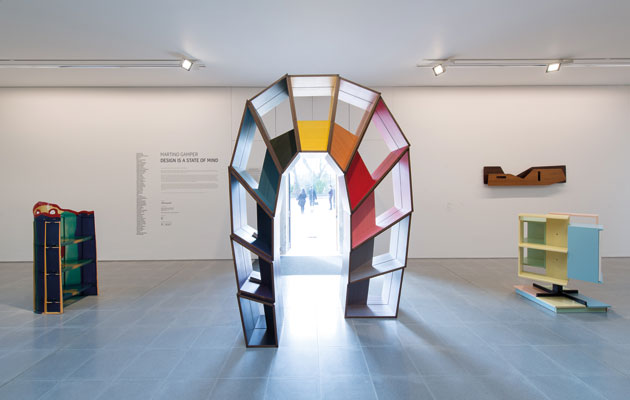|
|
||
|
It’s been a hectic year for the Italian designer. A solo show in Glasgow, new pieces for major brands and curatorial endeavours in London and Milan have revealed him to be not just one of the design world’s most prolific operators, but also one of its most original thinkers When Icon interviewed Martino Gamper in 2007, he was working on the 75th of his 100 Chairs in 100 Days, the ambitious project that made his name: witty, mutant, irreverent hybrids that spliced together design classics with furniture found on the street. “Good design,” Gamper says, “is when there’s a functionality that’s then challenged.” Coincidentally, when I visit his studio – a former print works that is full of his trademark bricolage – in November 2014, he is working on the 75th project on his annual job sheet. It has been, Gamper acknowledges, an incredibly busy year.
In a State of Repair, Gamper’s fixing workshop in Milan Gamper’s studio is crammed with objects that have just returned from his solo exhibition, Tu Casa, Mi Casa at the Modern Institute in Glasgow, where he transformed the white cube into a home furnished with his experimental, awry compositions. This summer, Gamper also curated the exhibition Design is a State of Mind at the Serpentine Gallery. “It was quite an important honour,” Gamper says of this first curatorial endeavour, for which he paired shelving systems – rare pieces by Franco Albini and Gio Ponti, alongside his own designs and inexpensive units from Ikea – with various designers’ collections – Enzo Mari’s paperweights, Mark Newson’s knives, Jurgen Bey’s taxidermy.
Gamper was the cover star of our January 2015 issue These cabinets of curiosities revealed Gamper’s idiosyncratic, improvisational approach, and were shown alongside clips from Jacques Tati’s Mon Oncle, a cautionary tale about design taking itself too seriously. “Designers sometimes have these utopian ideas,” Gamper says, “that we can change the world, and make it this super-futuristic place”. “I don’t see myself as a designer who wants to create a utopia in this way. I see design as changing things on a smaller scale: it’s about inspiring people, and that’s a very important and powerful thing as well, which changes the world without having to claim it.” |
Words Christopher Turner
Photographs Jenny Lewis
Images: Hugo Glendinnig, Angus Mill |
|
|
||
|
In March 2014, Gamper curated Design is a State of Mind at the Serpentine Gallery |
||
|
Over the past year, in his many exhibitions, Gamper has emerged as something of a champion of the skills of craftsmanship. With In a State of Repair, he transformed the La Rinascente department store in Milan into a jumble sale of free fixing. He paid groups of local artisans to mend items people brought along, choosing not to disguise but rather make an aesthetic of this patching. There was a cobbler, a leatherworker, a basket weaver, a bike mender, a bookbinder and someone with a 3D printer making spare parts. The project played on the idea of customer care, and made a powerful statement about commodity fetishism and planned obsolescence.
The Recto Verso bentwood chair “Just because something is broken,” Gamper explains, “it doesn’t mean that object has to be discarded. As designers we should think about how objects might be fixed. Resources are getting scarcer and people feel a certain affection towards objects, and suddenly this object doesn’t work and you have to chuck it out and buy something new. Fixing for me is a state of design – when you fix something it’s a creative process.”
Shelves of Gamper’s own design also appeared at the show he curated at the Serpentine Gamper, who once taught at the Royal College of Art, curated another project during Salone, From-To, the result of his pairing of ten young designers with Italian artisans. He also collaborated with major brands this year, creating the organic Vigna chair for Magis, and a set of swirling, multi-coloured pieces for Moroso. And he produces and sells pieces straight from his studio too – such as the Recto Verso bentwood chair, first shown during the London Design Festival. “I don’t think you’re any less of a designer if you don’t work with the big brands,” he says. “I get a lot of joy from tinkering in my own workshop.” This article first appeared in Icon’s January 2015 issue. Buy back issues or subscribe to the magazine for more like this |
||
























